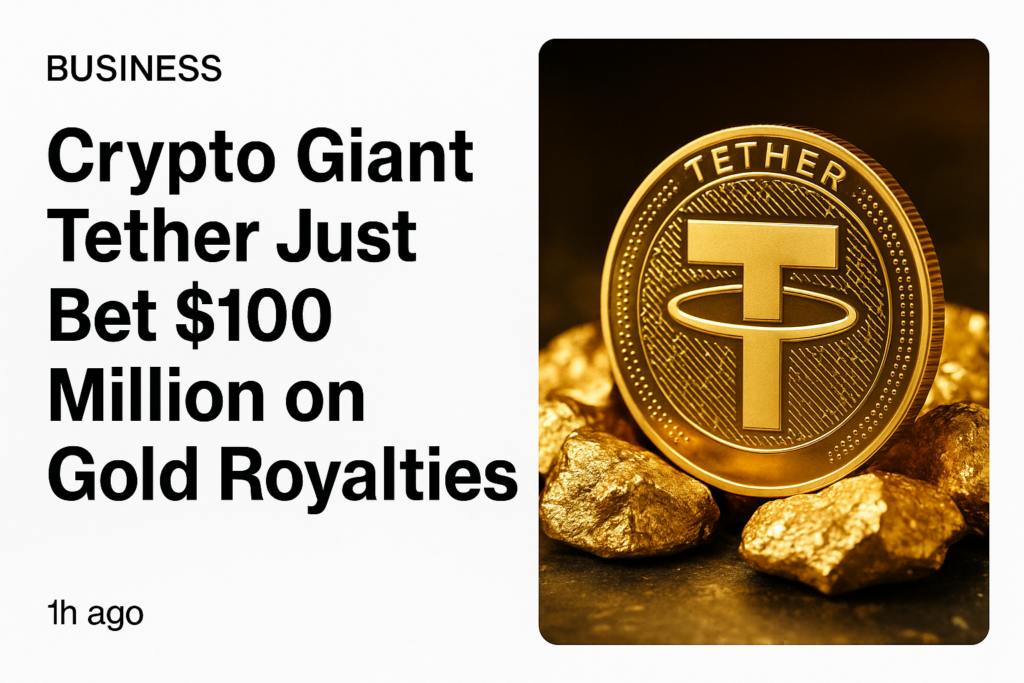Issue #74, Volume #2


What’s The First Principle Of Great Investing? Use Other People’s Money
This is Porter’s Daily Journal, a free e-letter from Porter & Co. that provides unfiltered insights on markets, the economy, and life to help readers become better investors. It includes weekday editions and two weekend editions… and is free to all subscribers.
| This kind of investing is something that most people never figure out… Every person has the right to wealth… How to build an ultra-low-volatility portfolio… The real secret: use other people’s money… Nike on a comeback, while Coke rolls along… China is pulling back investments in the U.S… |
Last night, I showed my 14-year-old son, Seaton, how to make $60,000 in less than 10 minutes.
He was mesmerized.
And then I showed him how, over the last 90 days, I’ve personally used this technique to generate more than $300,000 in income. “Dad, that’s enough money to pay for your new Aston Martin!”
He’s a sharp kid.
But what he really couldn’t believe was that I made all that money with only 11 trades. And I didn’t take losses on any of them. In fact, most of these positions I closed in less than 10 days.
This kind of investing is something that most people never figure out. But it is the most powerful wealth-building technique I know.
This knowledge is part of the “birthright” that I am giving to my sons. They will understand the path to true wealth and complete financial independence.
I hope you’ll let me give you the same birthright. I genuinely believe every person has the right to wealth. In a free market, you are rewarded for your contribution to society and the economy. My investing helps maintain the market’s efficiency and thus helps provide capital where it’s needed most.
Over the next three Daily Journals I’m going to share with you the three most important principles of great investing.
And then, next Friday, July 4, I’m going to send our Partners a video in which I’ll demonstrate my own actual portfolio. I will show you, step by step, how I put these principles to work. So far, this year, this strategy has led to 54% total returns.
There’s absolutely no reason you can’t achieve results like this too. All you have to do is build the right portfolio and know how to use it.
And I can show you exactly how to do it, using just three simple principles.
This has been on my mind this week because I’ve been teaching Seaton these principles. And when he turns 16, as I have already done with my older son, Traveler, I will give him a “birthright trust” – an account that will assure him substantial personal wealth by the time he’s 30 years old.
These principles are what guided the construction of Porter’s Permanent Portfolio and, as you probably know, the results have been fantastic.
Without using any leverage and while keeping about 25% of the portfolio in cash-like investments (short-term fixed income), we’ve generated total returns of almost 20% (+19.4%) in less than a year, far outpacing the returns of the overall stock market.
Most newsletter writers would boast about the few big winners from the portfolio, like Bitcoin (+69%), EQT (+64%), Philip Morris International (+51%), and W.R. Berkley (+30%).
But if you understood our family’s birthright principles, you’d pretty much ignore those outliers. You’d understand immediately what’s far more important is this number: 0.51. That’s the beta of the Permanent Portfolio.
I know most of you are going to stop reading as soon as you see a word like beta. Terms like beta and trying to think about the impact of leverage on a portfolio is difficult, especially if you’re new to investing. But try to stay with me. Because these ideas are the real key to producing outstanding results.
Finance, like all professions, uses jargon to try and confuse everyone. But beta is a very simple concept: it’s a measurement of relative volatility. Beta is determined by measuring the standard deviation of the monthly changes to the value of a financial instrument (a stock, a portfolio, etc.) and then comparing that to the stock market’s volatility.
When you see beta, just think: which price fluctuates more… the individual stock or the S&P 500?
The beta of our Permanent Portfolio is 0.51. Thus, our portfolio has half the volatility of the stock market. What’s important (and incredibly valuable) about our approach to portfolio construction is that by using non–correlated assets (some zig when others zag) we have dramatically reduced the portfolio’s volatility.
And that means… It can be safely leveraged. Using 2x leverage (investing a $1’s worth of borrowed money per $1 worth of equity) on our portfolio would only produce as much volatility as the stock market does normally. That’s an incredible attribute! It shows that our portfolio is producing wealth extremely efficiently.
The first principle of being a great investor is learning to make money with other people’s capital.
If you study Warren Buffett’s results at Berkshire Hathaway, you’ll find that his 20% annual returns over the last 50 years exactly match the annual increase to Berkshire’s insurance float. Buffett is a good stock picker – that’s true. But he became the world’s best investor because of his access to vast amounts of capital via his Berkshire’s float. Research into Berkshire’s results by AQR Capital Management revealed the impact of the insurance float was tantamount to 6x leverage across Berkshire’s portfolio.
Buffett is the world’s best investor because he had access to the most amount of other people’s money.
For individual investors, the same concept applies: if you’re a good investor, the more leverage you can use, the more money you will make. And the key to using leverage safely is having a very efficient portfolio.
A low volatility approach will prevent margin calls and big drawdowns. That’s why investing in very stable, ultra-high quality “Lindy” businesses like Philip Morris International (PM, beta: 0.54), Coca-Cola (KO, beta: 0.46) and McDonald’s (MCD), beta: 0.56) won’t merely produce outstanding total returns, it will do so with precious little volatility. And thus, these portfolios can be safely and efficiently leveraged.
When you combine ultra-low volatility equity portfolios with other asset classes that are non-correlated (like bonds, via property-and-casualty stocks) and sound money (gold, Bitcoin), you can build an ultra-low-volatility portfolio. That’s the real secret to Porter’s Permanent Portfolio.
How can you know if a portfolio is safe enough to leverage? Look at the portfolio’s Sharpe Ratio. Again, if you haven’t thought about this idea before, it can be a little complicated. But it’s actually very simple. The Sharpe Ratio is how much return a portfolio is generating per unit of volatility. If a portfolio has a Sharpe Ratio above 1.0 then adding more leverage will increase your returns more than it increases volatility. And that means you can efficiently use leverage to make higher returns.
The Permanent Portfolio has a Sharpe Ratio of 1.7 – mostly because of its extremely low beta. And that means using leverage with this portfolio will produce outstanding results.
I know that’s true because using this exact approach and a considerable amount of leverage, my own account is up more than 50% this year. I’ve been running my portfolio with around 2x leverage, which means I’m enjoying roughly twice the total return as an unleveraged portfolio. Most of my returns have come from Philip Morris (PM), Franco-Nevada (FNV), and Venture Global (VG) – all stocks I’ve recommended to you. And, because I’m using a permanent portfolio structure, my portfolio’s Sharpe Ratio is an incredible 2.1. Thus I’ve been able to use leverage very effectively to drive higher returns.
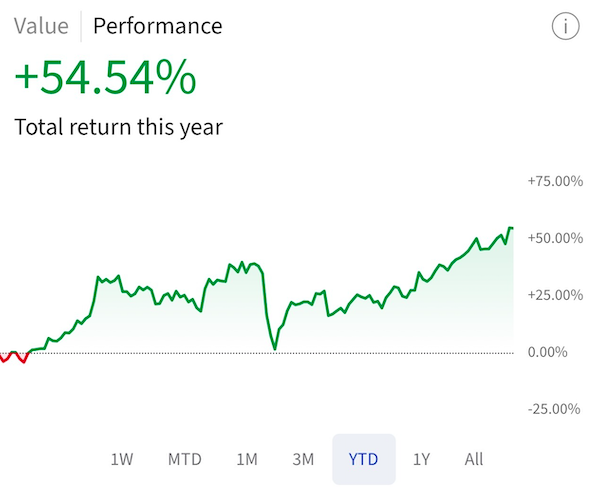
Through June 27, 2025:
- +54.5% total return
- maximum drawdown: -27%
- standard deviation: 2.99%
- Sharpe Ratio: 2.01
- Top performers: Franco-Nevada (FNV), Philip Morris (PM), Venture Global (VG)
I’m further enhancing these returns by using the available margin on my account to sell put options whenever there’s a big increase in volatility. This allows me to safely apply enormous amounts of capital into my best and safest ideas, without having to actually own the stocks.
I’ve written about buying stocks when the CBOE Volatility Index (VIX) goes above 30. That’s also when you want to sell puts to produce big gains. In Q2, after the big jump in market volatility in early April, I was able to sell put options on The Hershey Company (HSY), Philip Morris (PM), Applied Materials (AMAT), Uber Technologies (UBER), and Venture Global (VG) – trades that generated another 1,000-basis points (10%) of return on my portfolio. And it’s this kind of trading that I was teaching my son Seaton this week.
While great opportunities like these don’t occur each quarter, there’s typically at least one quarter a year where selling puts can add substantially to your annual returns. We launched The Trading Club in May while volatility was still pretty high and the returns that analyst Ross Hendricks has generated with those positions has been outstanding. Here are just a few of them.
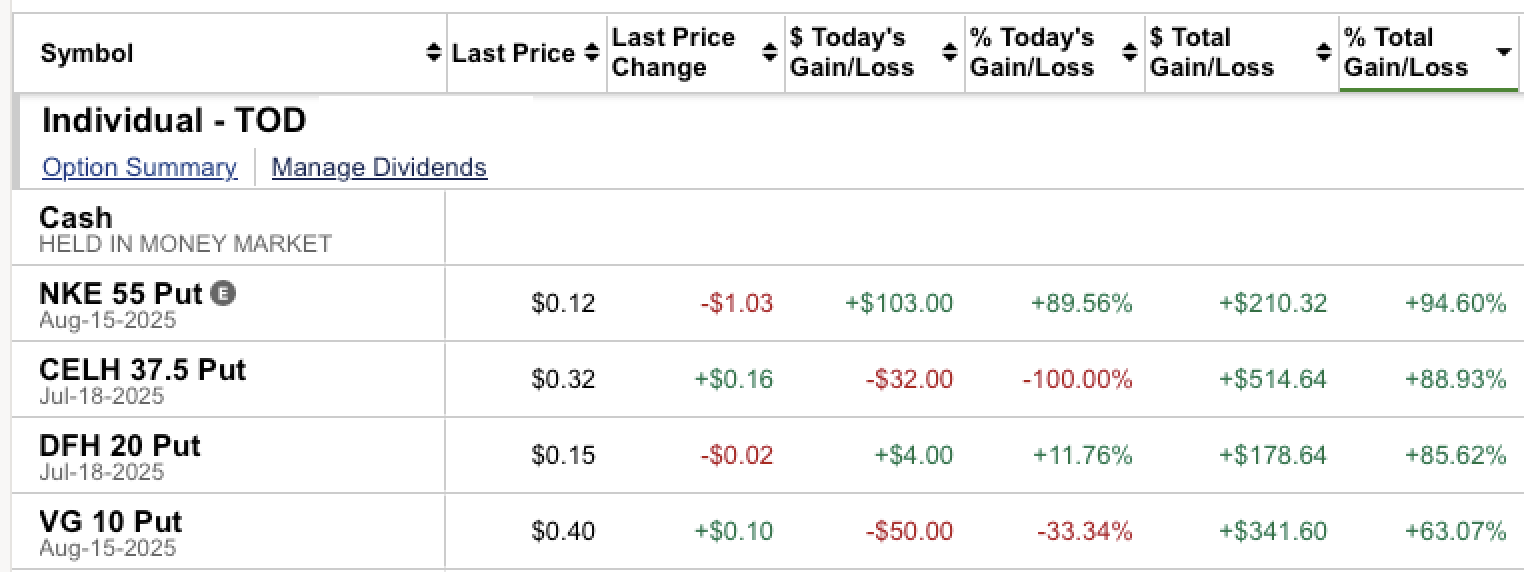
As Trading Club members know, the video we produced that showed everyone exactly how to make these trades (we have a house account funded with $100,000 that’s actively trading all of these positions) really helped subscribers see how safe and easy this kind of trading can be.
Using leverage across a low beta portfolio – with opportunistic put selling – is the best way I know to gain access to additional capital and routinely beat the market by a wide margin. It works so well because it’s an application of the first principle of great investing: use other people’s money.
So, next week, I’m going to do something I’ve never done before. I’m going to sit down in front of the camera and show you exactly how I use these principles to produce what most people think are unbelievable returns, consistently, with my own investing. I’m going to show exactly how I do it – step by step.
I hope that will encourage you to take the next step toward building your own birthright trust.
More about all of this next week.
Porter
P.S. This inside look at my own personal portfolio will only be available to Partner Pass members. If you’re interested in becoming a Partner, please be aware that our open-enrollment period begins on Monday, June 30. Please give us a call on Monday to learn more about becoming a partner: 844-933-9986.
Crypto Giant Tether Just Bet $100 Million On Gold Royalties
Tether — the $155 billion stablecoin titan — just acquired 92 million shares of a gold royalty company. Not bullion. Not Bitcoin. They bought the one asset that’s outperformed gold by 150X since 2007. Why is the most profitable name in crypto buying up royalty income streams tied to gold? Because they realize something Wall Street and regular investors are still ignoring…
Go here for details on The Gold Royalty Retirement Plan – and find out what Tether knows.
Three Things To Know Before We Go…
1. Weak consumer income and spending. The latest data from the Bureau of Economic Analysis showed that consumer spending declined 0.1% in May, versus economist expectations of a 0.1% increase. Personal income fell 0.4%, against expectations for a 0.3% rise. The latest GDP data showed consumer spending expanding to just 0.5% in Q1, the weakest reading since the COVID-19 lockdowns in Q2 2020. Such weak levels of spending does not bode well for future U.S. economic growth.

2. Coke flexes its pricing power. In Coca-Cola’s (KO) Q1 results, the company announced it boosted what it charges for a can of soda (and other procuts) by 5%, marking the 16th consecutive quarter of increasing prices by at least 5%. Coke provides a real-world case study on the power of a world-class brand combined with a capital efficient business model. At 136 years old, its enduring strength allows it to continue posting impressive growth rates, including average revenue growth of 9% per year over the past four years.
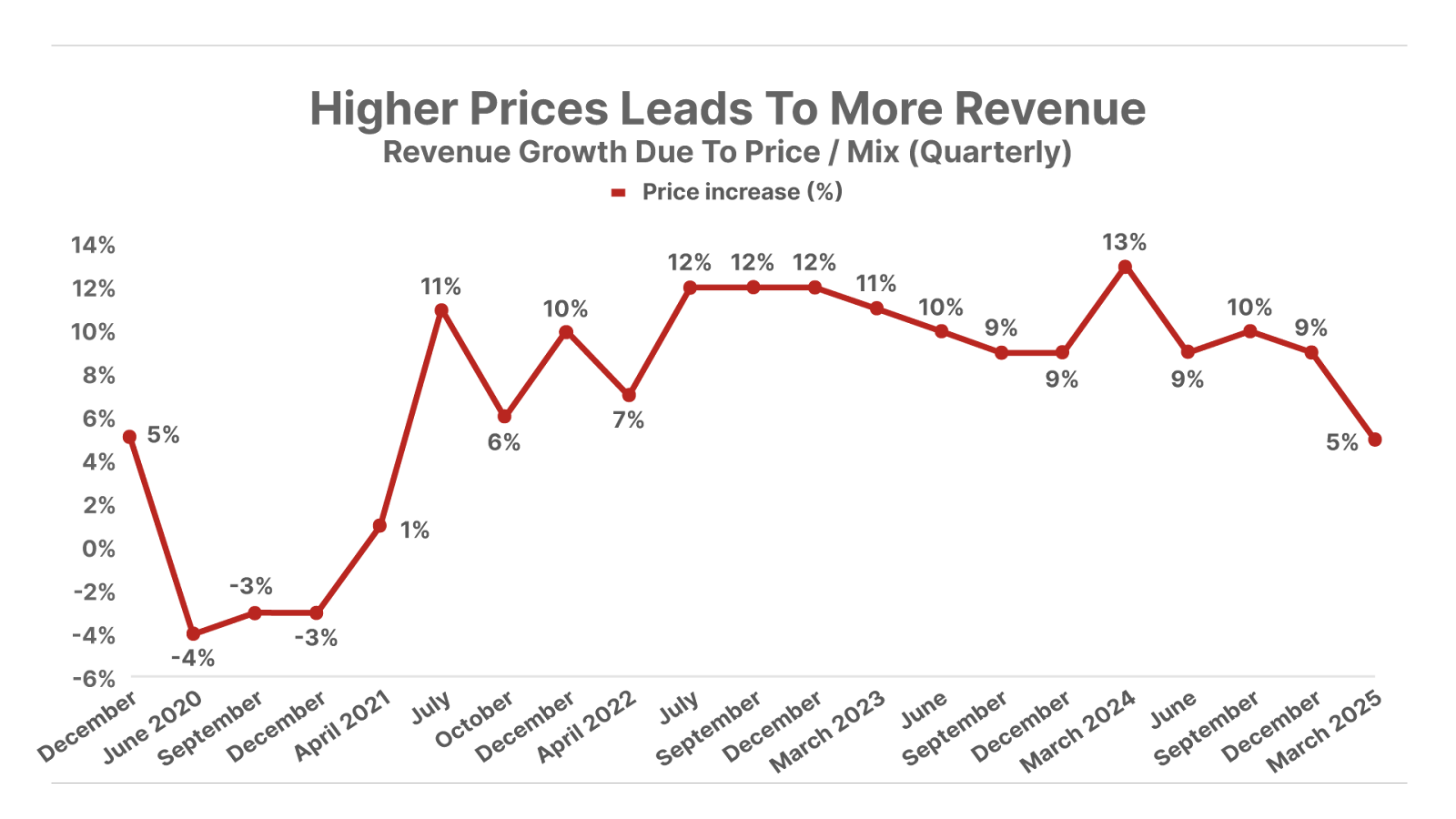
3. Nike soars as worst-case fears fade. Nike exceeded Wall Street’s estimates for revenue and earnings in its fiscal Q4 earnings results published yesterday. Management also noted a strong future order book, and estimated a mid-single-digit sales decline in the current quarter – a significant improvement from the double-digit declines in Q4, indicating the brand is gaining sales momentum. Nike shares rose 17% (as of noon), to $74. We see more upside ahead. We made Nike a “Best Buy” in the Big Secret On Wall Street starting on January 29 when shares traded at $76, and continued the Best Buy recommendation through April 16, when shares traded at $54.
And One More Thing… China Pulls Back On U.S. Investments
China’s $1.3 trillion sovereign wealth fund was once a major investor in the U.S., holding large stakes in firms like Blackstone and Morgan Stanley, and even joint venturing with Goldman Sachs. But the times have changed – the fund has redirected capital toward domestic opportunities and into emerging markets, particularly in Asia and the Middle East. Rising trade tensions under Trump’s tariff policies and tighter U.S. scrutiny – through the Committee on Foreign Investment in the United States (“CFIUS”), which can block deals on national security grounds – have made investing in America more difficult. This shift reflects a broader decoupling trend in U.S.-China financial ties.
Tell me what you think: [email protected]
Good investing,
Porter Stansberry
Stevenson, Maryland
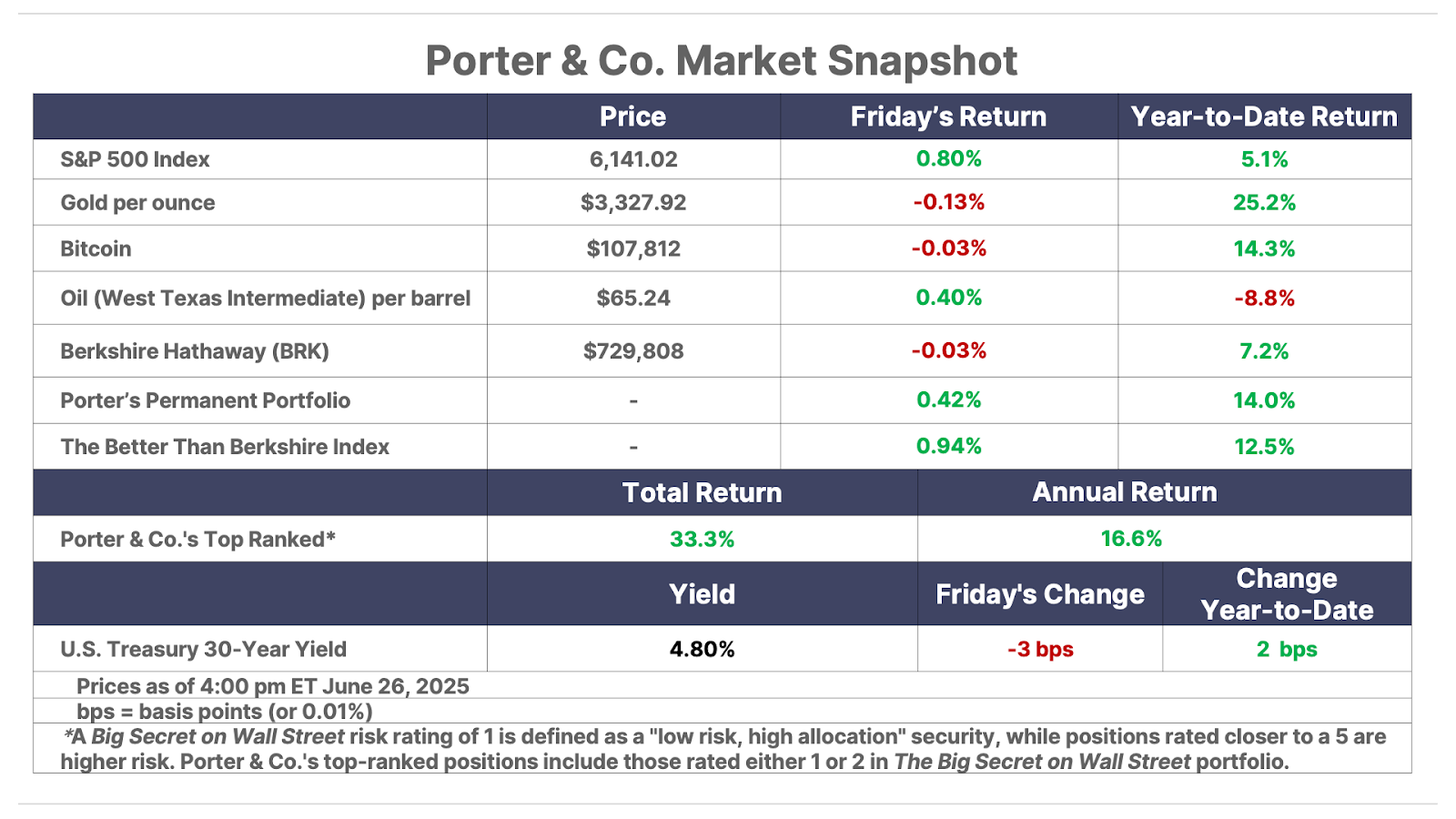

Please note: The investments in our “Porter & Co. Top Positions” should not be considered current recommendations. These positions are the best performers across our publications – and the securities listed may (or may not) be above the current buy-up-to price. To learn more, visit the current portfolio page of the relevant service, here. To gain access or to learn more about our current portfolios, call Lance James, our Director of Customer Care, at 888-610-8895 or internationally at +1 443-815-4447.
